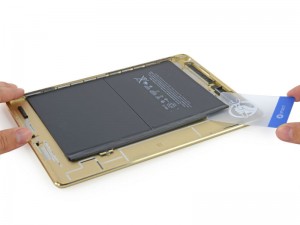

One of the most under-appreciated features of the iPad is its fantastic battery life. Even with a high resolution screen and a powerful processor, Apple’s tablet offers a battery life of 4 to 6 (or more) hours in the air–better than almost every other competing tablet. This is a huge advantage in the cockpit, as it’ll last for the duration of all but the longest flights.
But there are a number of things you can do to improve the performance of your iPad battery and keep it in top working condition. First, it’s important to know what type of battery the iPad (and the iPhone, for that matter) uses, and how it works. Like most consumer electronics, the iPad uses a lithium-ion polymer battery, often called a LiPo battery. These are the standard in portable devices now because they have a high power density but are very lightweight. When you think about it, it’s quite impressive how large a battery Apple manages to put into such a slim device.
Another major advantage of LiPo batteries is the way they are charged. There is no “memory effect” like older Nickel Cadmium batteries, so you can charge your iPad anytime you want and even leave it on a charger overnight. The battery will also charge very rapidly, to about 80% in a few hours, while the last 20% is more of a trickle charge and takes longer. This charging pattern is very handy for pilots, especially in the cockpit. LiPo batteries also hold their charge for a long time, so a fully charged iPad that is stored for a month will still have most of its charge.

So far we’ve talked about the “battery life,” meaning how long the iPad will run on a single charge. But Apple also specifies a “battery lifespan,” which is the number of times you can charge and discharge the battery before it starts to lose capacity. The iPad was designed so that, after 1000 charge/discharge cycles, it will still have 80% of its battery capacity. Note that it’s not considered a “charge cycle” every time you plug in your iPad. If you used 20% of your iPad’s battery life every day for 5 days, and recharged it each day to 100%, that would be one charge cycle. So 1000 charge cycles is actually quite a long time (probably years of use for most people).

With that background in mind, here are some tips for getting the most out of your iPad’s battery:
- Heat can permanently reduce battery life, especially if you use your iPad at temperatures higher than 95 degrees. The cockpit certainly can get that hot, so the best advice is to never leave your iPad in the airplane and never place it in the sun. Also, charging the device when it’s over 95 is even worse, so try to do your charging at home if you often fly in hot conditions. Finally, airflow does help so remove your iPad from its case if it’s getting hot.
- Cold conditions (below 32 degrees) can also affect battery performance, but this is a temporary issue. Again, you shouldn’t store your iPad in the airplane on a cold night, but once it warms up the battery should give you normal life.
- Use your iPad regularly. Lithium-ion batteries are meant to be used hard, so don’t be afraid to use and recharge your iPad often. In fact, if you don’t regularly use your iPad, you should perform a complete charge cycle at least once a month (where you fully discharge the battery, then charge it up to 100%).
- Keep your iPad updated to the latest version of iOS. In addition to the many new features Apple adds when they update their operating system, they often include fixes and performance enhancements for the battery. It’s a good idea to always have the latest version of iOS.
- Adjust screen brightness and wireless radio settings for maximum battery life. If you don’t need the screen at max brightness, turn it down–this can significantly reduce battery drain. Likewise, if you don’t need the LTE data service or Bluetooth in flight, turn these services off (here’s how).
- Use the battery utility in the Settings app to monitor what apps are using battery life. iOS is pretty good about shutting down background apps before they become real parasites, but it’s worth looking at this once in awhile.
One downside to the iPad battery is that there is no way to replace it in the field. If your battery needs service or replacement, it must be sent back to Apple or taken to an Apple service provider.
Want to learn more? One of our most popular articles on iPad Pilot News shares a number of helpful tips on charging your iPad at home and in the cockpit. Also note that the iPad battery does meet the standards required by Advisory Circular 120-76C for use as an EFB. And full iPad battery details are available on Apple’s website.
Source: Ipad appsHow to maximize iPad battery life – tips for better performance